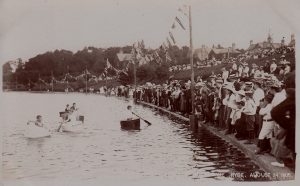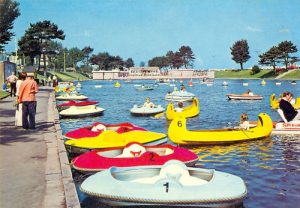The Canoe Lake

Juvenile Regatta August 1905
At the beginning of 1878 the Admiralty and the Board of Trade gave their consent to the Council for constructing a canoe lake on the shore to the eastward of the Victoria Pier, something that would no doubt have given much satisfaction. It was hoped that the Corporation would set to work and add this comparatively inexpensive attraction to the other attractions of the town. Improvements were not regarded with such indifference away as they were in Ryde, as proved by the fact that almost every one of the London daily papers devoted space to chronicling the proposed improvement, which, was perceived as a complete novelty.
The dwarf wall which was to enclose the lake, would be more like a roadway, and made wide enough so that people could promenade upon it at low tide, and watch the gambols of the young urchins in the water, which would nowhere be deeper than 2ft. This would recommend Ryde to those who had families, for it was not many places that could offer the attraction of a sheet of water, upon and in which, children could disport themselves to their heart’s content without fear of drowning.
On 28th December that year it was stated that the subject of making a canoe lake where children could amuse themselves without any danger, by enclosing a portion of the foreshore, had been frequently discussed by the Council, but it was regretted that owing to some difficulty with the owners, who asked a very high rent for the land, the project had fallen through for the moment.
The subject of a canoe lake was brought up time and again by the Council, and in March 1879 it was decided to go ahead with the development of the sea front to Apley. They would form a boating lake by leaving the shore as it was, and enclosing beyond it, and would lay washed shingle at the bottom. Round the lake would run a footpath, 10ft wide. The length would be 850ft by 206ft. There would be a dwarf party wall round it, and that would enable them to have the height of water at any they liked. At each end of the lake there would be a lawn, which could be used for lawn tennis. The lake could be supplied with fresh water from the sluice in winter, and used for skating. The water could be discharged when necessary at low tide. The contract for constructing the new carriage drive and the canoe lake at Apley was given to Messrs. Hill and Co., of Gosport.

A more modern photo
By August 1881 the canoe lake was completed and carriages could drive round it and it presented much the appearance that the engineer intended. There had been complaints that the lake was frequented by just the very class it was not intended for. By the late summer of 1883 the canoe lake and Esplanade were brought into use for the Regatta, including bicycle races around the roadway of the lake and various sports on the lake itself. The potential for its use was becoming clearer to the rate-payers, who were beginning to think it wasn’t such a bad idea after all.
Over the years from what was originally a depression in the sand where children could play, it has been developed gradually and a lot of different activities have taken place there. Many clubs have used it, canoe’s, sailing boats, model yachts, paddle boats, juvenile regattas and much more. The Reeves and Cotton families were in business to operate boats on the Canoe Lake and bathing machines, Mr Reeves being a boat proprietor for 40 years. See more about Albert Reeves here.
Source: IW Observer, RSHG Archive
Images: RSHG Archive, Roy Brinton Collection
Article: Ann Barrett

